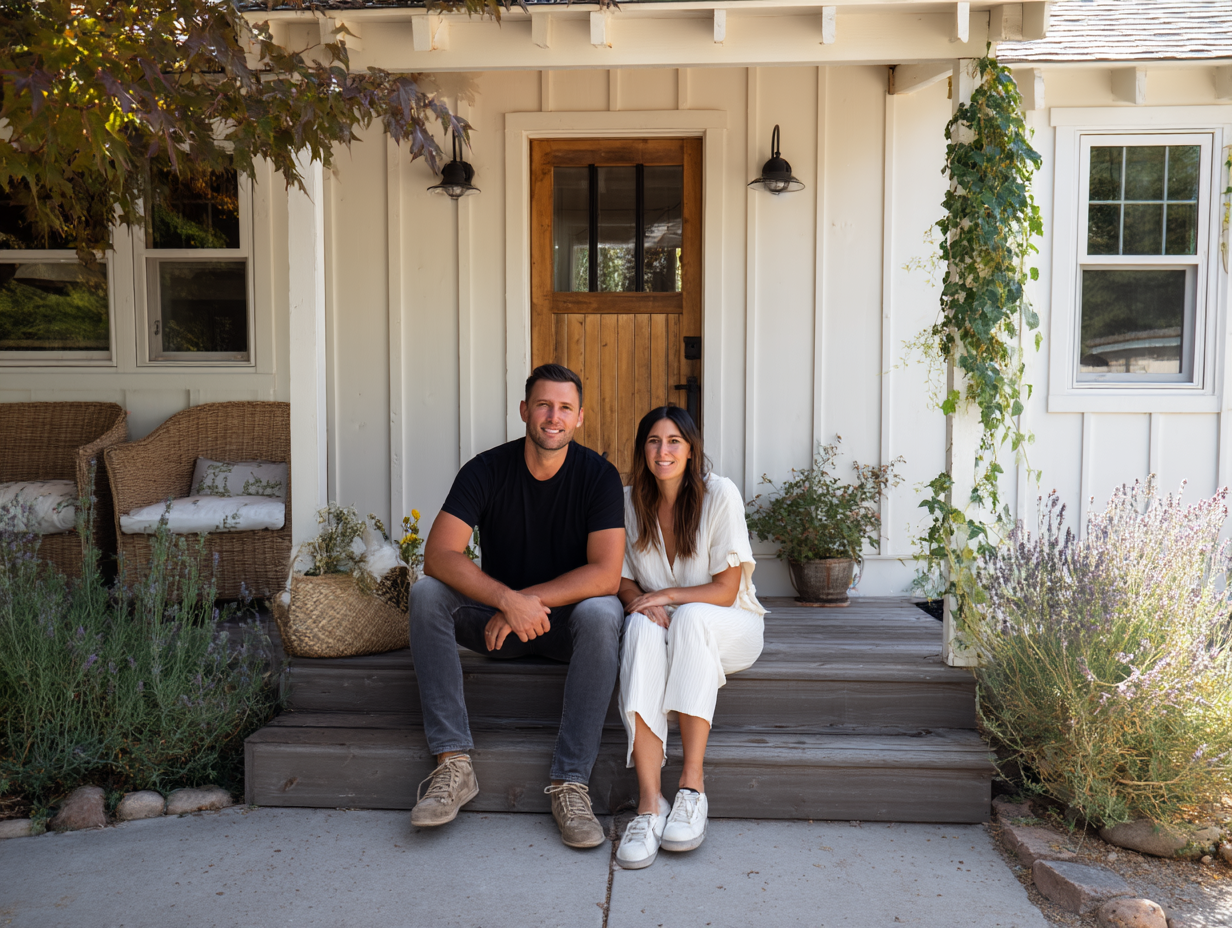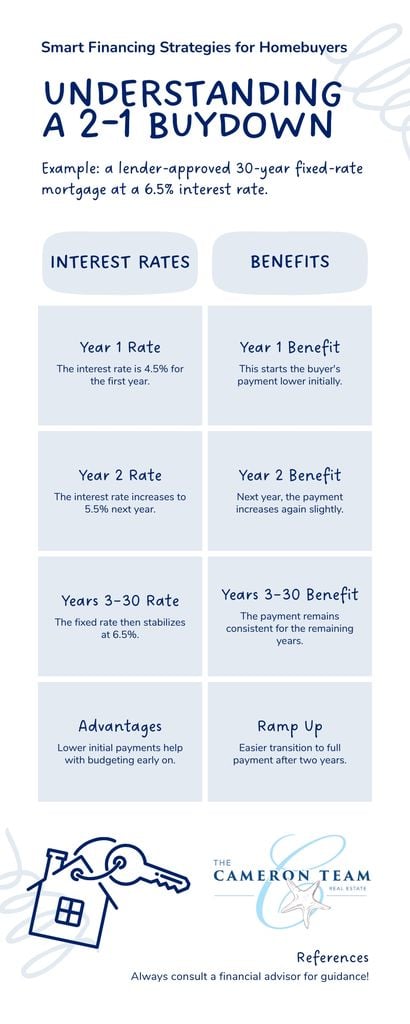If you’re house hunting in today’s market, chances are you’ve encountered two phrases that seem like insider jargon from a mortgage playbook: “2-1 buydown” and “seller concessions.” And while they may sound complex, these financing tools are surprisingly accessible—and potentially powerful—ways to make homeownership more affordable, especially in a market with higher interest rates.
In this blog, we’ll break down exactly what a 2-1 buydown is, how seller concessions work, and how you can use them (separately or together) to lower your mortgage payments—either temporarily or over the life of your loan. Whether you’re a first-time buyer or returning to the market after a long break, creative financing strategies like these can give you a much-needed edge.
What is a 2-1 Buydown?
A 2-1 buydown is a mortgage financing arrangement where the interest rate is reduced for the first two years of the loan and then returns to the full rate for the remaining term.
Here’s how it typically works:
-
Year 1: Interest rate is reduced by 2%
-
Year 2: Interest rate is reduced by 1%
-
Year 3 through end of loan term: Interest rate resets to the original agreed-upon rate
For example, let’s say your lender approves you for a 30-year fixed-rate mortgage at 6.5% interest. A 2-1 buydown would look like this:
-
Year 1: 4.5%
-
Year 2: 5.5%
-
Years 3–30: 6.5%
This temporary reduction means your monthly payments are significantly lower during the first two years, easing you into the full cost of the mortgage.
Why Use a 2-1 Buydown?
Buydowns are especially useful when interest rates are higher than normal or when buyers need more flexibility in the early years of homeownership. Here are a few reasons to consider one:
-
Lower Initial Payments
You’ll have smaller mortgage payments during the first two years, which can help with the transition from renting or saving for upfront costs like furniture or home repairs. -
More Room in Your Budget
With lower payments early on, you can redirect funds toward building an emergency savings account, investing in improvements, or simply adjusting to your new monthly expenses. -
Hedge Against Future Refinancing
If interest rates drop in a couple of years, you may refinance before the full rate kicks in, potentially avoiding the higher payments altogether. -
Seller Incentives
In a buyer’s market or on slower-selling properties, some sellers may be willing to fund the buydown as an incentive to get their home sold.
Who Pays for the Buydown?
The cost of a 2-1 buydown is not absorbed by the lender—someone has to cover the difference between the full interest payments and the reduced ones during the first two years. Typically, this cost can be paid by:
-
The home seller
-
The builder (in the case of new construction)
-
The buyer (less common, as it negates the benefit)
When the seller pays for the buydown, it’s often considered a “seller concession”—a broader term that includes any costs the seller agrees to cover on behalf of the buyer.
What Are Seller Concessions?
Seller concessions are contributions from the seller that go toward the buyer’s closing costs, prepaid taxes, insurance, or even mortgage buydowns. They’re commonly used to make a deal more attractive or to help buyers afford a home without having to come out of pocket for every expense.
Here are a few things seller concessions can cover:
-
Loan origination fees
-
Title insurance
-
Appraisal fees
-
Attorney fees
-
Property taxes or HOA dues
-
Mortgage buydown costs (like a 2-1 buydown)
The amount a seller can contribute varies by loan type:
-
Conventional loans: 3%–9% depending on down payment size
-
FHA loans: Up to 6%
-
VA loans: Up to 4%
-
USDA loans: Up to 6%
These concessions must be negotiated into the contract and approved by the lender, so it’s crucial to work with an experienced real estate agent who can help you strategize during the offer process.
Combining a 2-1 Buydown with Seller Concessions
One of the most powerful ways to lower your mortgage payment is to combine the 2-1 buydown with seller-paid concessions.
Let’s say you’re buying a $400,000 home and negotiating with the seller to cover $10,000 in closing costs. You could allocate some or all of that money toward the buydown. The exact cost of a 2-1 buydown will vary based on the loan amount and interest rate, but it typically falls in the range of 2–2.5% of the loan amount.
That means a seller could realistically cover the entire cost of a buydown if they’re motivated, or if the home has been sitting on the market for a while.
Why this combo works:
-
You get lower payments for the first two years (thanks to the buydown)
-
You bring less cash to the closing table (thanks to the concession)
-
You’re easing into homeownership with a smoother financial runway
What’s the Catch?
No strategy is perfect for every buyer, so it’s important to be aware of a few trade-offs:
-
Temporary Relief Only
A 2-1 buydown doesn’t change your interest rate permanently. After year two, you’ll need to be financially prepared for the full mortgage payment. -
Not Always Available
Lenders don’t always offer buydown programs, and sellers may not be willing or able to fund one—especially in hot markets where they receive multiple offers. -
Negotiation Required
Seller concessions and buydowns require savvy negotiation. Your agent will need to structure your offer to include these requests and ensure they align with loan guidelines. -
Appraisal Limits
If the seller agrees to pay for a buydown but the home doesn’t appraise for the full contract price, the lender may reject the concession or reduce the loan amount.
How to Ask for These in Your Offer
-
Work with Your Agent
Let your agent know upfront that you’re interested in a buydown or concessions. They can help tailor your offer and determine how much is reasonable to request based on the home’s days on market and seller motivation. -
Check with Your Lender
Not all loan programs allow for buydowns or the same amount in concessions. Have your lender run the numbers and confirm what’s allowed under your mortgage type. -
Make It a Win-Win
If the home has been sitting for a while, the seller might prefer offering a concession over dropping the price. A $10,000 concession can often feel more “palatable” to sellers than a $10,000 price cut. -
Get It in Writing
Your offer should clearly spell out the request, e.g., “Seller to pay $10,000 toward buyer’s closing costs and interest rate buydown.”
Final Thoughts: Creative Financing is the New Normal
In a market with high interest rates, affordability challenges, and cautious buyers, tools like the 2-1 buydown and seller concessions are more than clever—they’re essential. They empower buyers to ease into their mortgage while helping sellers get to the closing table without slashing their price.
If you’re planning to buy a home in the coming months, don’t overlook these strategies. Talk to your lender about buydown options and lean on your real estate agent to help negotiate seller-paid concessions that make your offer stand out.
With the right combination of timing, negotiation, and financing, you can secure a home that works for both your heart and your wallet.






